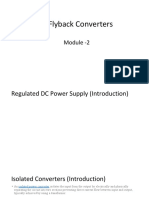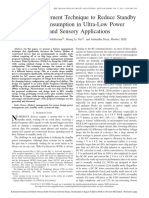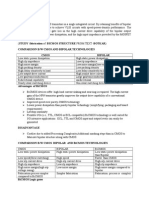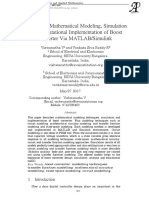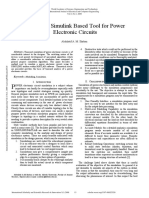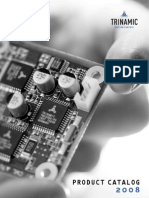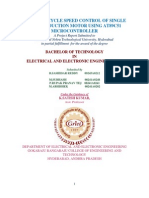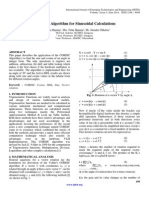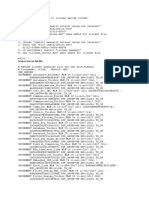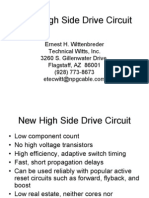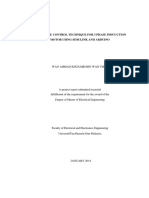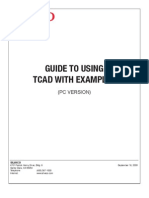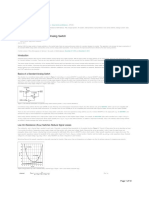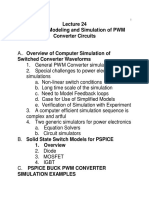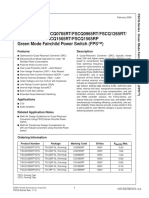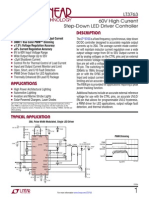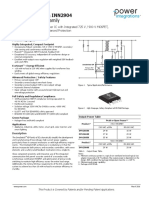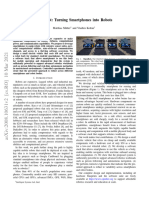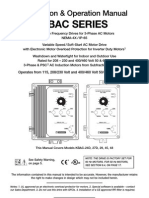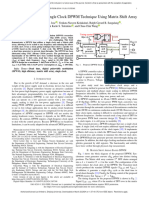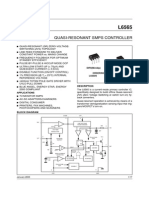Design and Simulation of Power Converters using the Ansoft Power Suite
Presenter: Roberto Prieto
Universidad Politcnica de Madrid (UPM). Spain
�Outline
The application: Interleaved converters Design of magnetic components for power converters using converters using PExprt Advantages of Integrated magnetics in Interleaved Converters Integrated magnetics component design using PExprt Converter design, including regulation loop: from PExprt to PExprt to Simplorer Digital control implementation with Simplorer System design: from the circuit level to the system level level
�Ansoft Power Suite
�Interleaved Converters Features
Paralleling
Load
+
Shift
+
Packaging
�Advantages of Interleaved Converters (I)
IL1 L1 IL1 IL2 L2 IL2 IL1 IC IC
Ripple cancellation Ripple cancellation
Small COUT Small COUT
IL2
2 converters 4 converters d = 50% d = 25%
�Advantages of Interleaved Converters (II)
Vs = 9V, Is = 10A
Vs = 24V, Is = 10A
�Advantages of Interleaved Converters (III)
Load
IIN/N
�Application of Interleaved Converters
Power Converter
Filter
Amp RF
Control
�Interleaved converters: Automotive application
High
DC-DC
Low
DC-DC
42V
12V
DC-DC
400V
12V
�Automotive Application: Multi-phase converters.
36 phases
Phase currents
2 1.5 1 0.5 0
Phase currents (A)
-0.5 0.0E+ 00
5.0E-06
1.0E-05
t (s)
1.5E-05
2.0E-05
2.5E-05
100.00
Very small size SMD components Output capacitors
E fficiency (% )
97.50 95.00 92.50 90.00 87.50 85.00 82.50 80.00 0 10
Only power stage Power stage + control
SMD is possible
20 30 40 50 60 70 Output current (A)
�Interleaved Converters design with Simplorer (I)
SMPS Library elements SMPS Library elements
�Simplorer SMPS library
SMPS library contains a wide list of averaged and switch level models
�Interleaved Converters design with Simplorer (II)
Efficiency ~86% Efficiency ~86%
1.00
Current at each phase (1.6A p-p) Current at each phase (1.6A p-p)
5.00
4.00
500.00m
3.00
0 0 5.00 10.00
2.00 9.95m 9.96m 9.98m 10.00m
Output Voltage Output Voltage
6.00 5.00
2.50
2.00 0 500.00u 1.02m
�Magnetic Component design with PExprt (I)
�Design with PExprt. Step 1: Design
�PExprt. Step 2: Select & Compare
�PExprt. Step 2: Select & Compare
�PExprt. Step 3: Optimize
�PExprt. Step 4: Circuit level simulation with
Simplorer
�Comparison of models at circuit level with Simplorer
Efficiency
1.00
1.00
86%
500.00m
max 84%
500.00m
Decrease due to parasitic effects
0 0 5.00 10.00
Efficiency Efficiency
0 0 5.00 10.00
5.00
Phase Currents
1.6A p-p
4.00
1.00
1.5A p-p
0
3.00
2.00 9.95m 9.96m 9.98m
10.00m
Current at each phase Current at each phase
-1.00
949.27u
960.00u
980.00u
999.90u
�Integrated Magnetics vs Discrete Components
Integrated Magnetics Integrated Magnetics
Output Voltage 5.23 4.00
4.94 4.00
Discrete Components Discrete Components
Output Voltage
2.00
2.00
0 0 500.00u 800.00u
0 0 500.00u 800.00u
Phase Currents 2.00
13.98 10.00
Phase Currents
-2.00 360.08u 370.00u 380.00u 390.00u 400.00u
-12.27 360.05u 370.00u 380.00u 390.00u 400.00u
�Integrated Magnetics Features in Interleaved Converters (I)
Multiphase Multiphase converters converters Magnetic Magnetic integration integration
Coupling Coupling
i1 v1 v2 v3 i2 i3 i4
i0
Load
Multiphase transformer (several implementations)
�Integrated Magnetics Features in Interleaved Converters (II)
v1 v2 v3 iO
i2 i3
Load
Standard cores
�Integrated Magnetics Features in Interleaved Converters (III)
Core A Core B Core A Core B Winding phase 3 Winding phase 1 Winding phase 2 Winding phase 4 Phase 2 Core A Phase 3 Phase 4
25% 0% Decoupled inductor Integrated transformer Integrated transformer + additional inductor
Winding phase 4
Volume comparison
125% 100% 75% 50%
Phase 1
Core B
�Design of Integrated Magnetics with PExprt
Features
Frequency dependent Capacitive effects Nonlinear core
�Simple procedure to define Integrated Magnetics in PExprt
�Flexible Winding Setup Definition for each core leg
�PExprt Model: Simplorer link
�Different bobbins can be assigned to each core leg
�Planar Integrated can also be defined
�Circuit level simulation with Simplorer
M1
MOSFET_LEG pwm
pwm1
M2
AM1 PExprtLink1
n
M1
MOSFET_LEG pwm
pwm2
M2
AM2
n
PEX
R1 C1
M1
STEP1
MOSFET_LEG pwm
E1
pwm3
M2
AM3
n
�Comparison of models at circuit level with Simplorer
M1
p
MOSFET_LEG pwm
pwm1
M2
Discrete Discrete
1.00
AM1 PExprtLink1
n
M1
MOSFET_LEG
Efficiency
pwm
Efficiency 1.00
PEX
Integrated Integrated
pwm2
M2
AM2
n
R1 C1
M1
STEP1
MOSFET_LEG pwm
E1
pwm3
M2
AM3
n
max 84%
500.00m
84%
500.00m
More stable behavior
0
0 0
1.00
5.00
10.00
5.00
10.00
1.5A p-p
2.00
2.2A p-p
-1.00 949.27u 960.00u 980.00u 999.90u
2.00
949.27u
The currents are in phase
960.00u 980.00u
999.90u
6.00 5.00
6.00 5.00
2.50
2.50
Faster than the uncoupled version
0
0 500.00u 1.02m
2.00
2.00 0 500.00u 1.02m
�Particular geometries might require Maxwell 3D
2D is feasible 2D is feasible
3D is necessary 3D is necessary
�Automotive Application: Multi-phase converters.
36 phases
Digital control is mandatory control is mandatory
�Control Implementation: Alternatives
Analog Analog 1 1 Continuous blocks: S-Transfer function
G(s)
Digital Digital
2 2
Discrete blocks: Z-Transfer function
G(z)
Discrete_PID
3 3
Discrete Fixed-Point : Synthesized VHDL code
�Digital Control for multiphase Converters
f = 3kHz
�Digital Control Implementation
Analog Implementation
Output Voltage
Analog PID
Duty Cycle
Soft Start Simplorer blocks
(Electric circuit)
�Digital Control Implementation
Digital Implementation
Discrete PID
(VHDL-AMS block)
Output Voltage
Duty Cycle
Simplorer blocks
Soft Start
(Electric circuit)
�Digital Control Implementation: Simplorer Results
Continuous time PID (Analog) Continuous time PID (Analog)
20.00
Output Voltage 3.50
Phase Currents
10.00
3.00
2.50 250.00u 300.00u 400.00u 450.00u
-10.00 250.00u 300.00u 400.00u 450.00u
Discrete time PID (Digital): sampling = 600kHz Discrete time PID (Digital): sampling = 600kHz
Output Voltage 3.50
20.00 Phase Currents
10.00
3.00
0
2.50 250.00u 300.00u 400.00u 450.00u
-10.00 250.00u 300.00u 400.00u 450.00u
�Digital Control Implementation: Simplorer based design
Overshot and settling time measurement
Initial simulations
Fitness function
Performance evaluation
(better when settling time is short) Tendency of the parameters
�System and Sub-System levels
Complete system Power system
The power system can not be modeled as an ideal system
The power system involves: involves:
Losses Dynamic limitations Temperature issues Failures
�Modeling approaches
Switch level models
Are based directly on the structure Provide information for each component in every switching cycle
Averaged models
Switching information is lost but structure is kept There are several techniques like: State space averaging Averaged switch modeling
Behavioral models
Based on the input-output behavior The model is a black box, the real structure is lost
�Simulation time
Simulation time
Subs istemaBaterias
Vinp Vop
Buck Regulado
42V/28V
+
V
-Averaged models -> 157 seconds -Behavioral models ->
Vinp
AMbat VMbat
29 seconds
Vinm
Vom
Vinm
Subs istemaGenerad
Vp Vinp
+
V
Vm
Buck Regulado
42V/28V
Vop
+
V
Vinp
Half Bridge Regulado
28V/1.8V
Voutp
Vp
+
V
VM28
Vom Vinn
VMc
Voutn Vm
5 times faster!!!
VMin
Vinm
Subs istCargasReg
Vp
Vinp
Half Bridge Regulado
28V/1.8V
Voutp
43.00
Vm
Subs istemaCargas NoRe
Vinn
Voutn
30.00
20.00
Vp Vinp
Half Bridge Regulado
28V/1.8V
Voutp
+
V
Vp
10.00
VMc2
Voutn Vm
Vm
Vinn
0 0 25.00m 50.00m 75.00m 100.00m 150.00m
Subs istemaCargas NoReg2
Subs istCargasReg2
�SMPS Library: PTool
Problems designing power systems
The lack of models for each DC/DC converter The lack of information on commercial converters Difficulty to develop the models Long simulation time All above problems multiplied by the number of converters
Get optimized VHDL-AMS models for DC/DC converters in minutes
�SMPS Library: PTool
PTool converters features: Input characteristics Output characteristics Dynamic response Static response Remote control Thermal behavior Protections Power sharing Cross regulation
�Simplorer System Level Models
vi_p
vo1_p
Behavioral
vi_n vo1_n
�Simplorer System Level Models
vi_p vo1_p
Behavioral
vi_n vo1_n
Efficiency comparison 100.00
3.40
System Level and Switch
Behavioral
50.00
2.00
Switch level
0 0 5.00 10.00
0 0
Total simulation time: 700us
200.00u
400.00u
520.00u
Behavioral: 0.992s
Switch level: 352.54s
